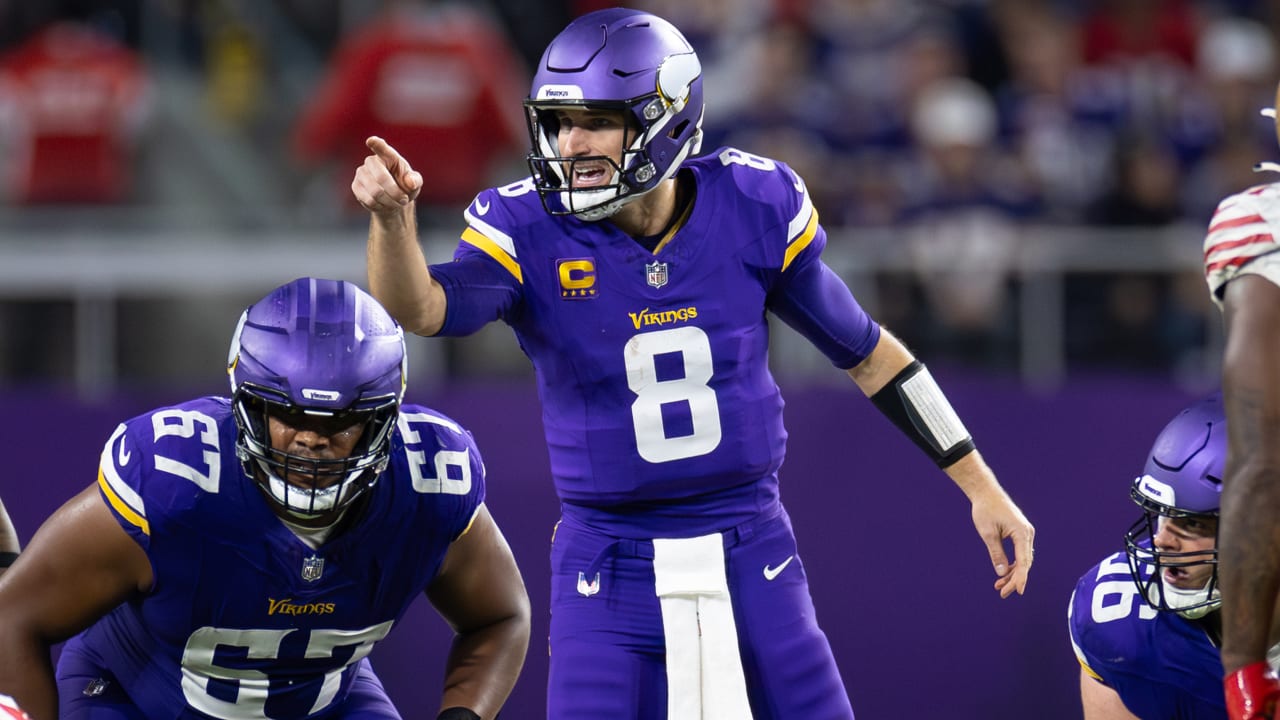Kirk Cousins Benching Calls Attention to QB Succession Plan Pitfalls. The recent benching of Minnesota Vikings quarterback Kirk Cousins has ignited a crucial discussion surrounding the complexities and potential pitfalls of NFL quarterback succession planning. This situation, far from being an isolated incident, serves as a stark reminder of the challenges teams face in navigating the transition from a veteran quarterback to a future leader.
The Vikings’ experience highlights the need for proactive, multifaceted strategies, encompassing player development, strategic drafting, and shrewd free agency maneuvering, all while carefully managing financial implications and team morale.
The analysis will delve into the Vikings’ historical quarterback struggles, examining Cousins’ performance metrics and contract details, and exploring potential succession plans. We’ll assess the impact of the benching decision on team dynamics and media relations, drawing parallels with similar situations across the NFL to extract broader lessons for league-wide success in this critical area.
The Vikings’ QB Situation: A Historical Perspective
The Minnesota Vikings’ quarterback position has experienced a rollercoaster of successes and failures since the Brett Favre era. Examining this history provides valuable context for understanding the current debate surrounding Kirk Cousins and the team’s future at the quarterback position. This analysis will trace the team’s quarterback performance, considering the influence of coaching changes and offensive schemes.
Vikings Quarterback Performance Since Brett Favre
The following table details the performance of key Vikings quarterbacks since Brett Favre’s tenure, highlighting their passing statistics and significant events impacting their performance.
| Player | Year | Passer Rating | Significant Events |
|---|---|---|---|
| Brett Favre | 2009 | 81.6 | Joined the Vikings after a long career with Green Bay; led the team to the NFC Championship game. |
| Tarvaris Jackson | 2006-2009 | 69.1 | Showed promise but inconsistency limited his success. |
| Christian Ponder | 2011-2013 | 70.0 | A first-round draft pick, his tenure was marked by inconsistency and injuries. |
| Teddy Bridgewater | 2014-2016 | 88.1 | Showed promise early but suffered a devastating knee injury. |
| Sam Bradford | 2016 | 97.0 | Started the season strong but suffered injuries. |
| Case Keenum | 2017 | 98.3 | Led the Vikings to the NFC Championship game. |
| Kirk Cousins | 2018-Present | 96.0 (average) | Signed a lucrative contract; consistently high passing yards but playoff success has been elusive. |
Coaching changes and shifts in offensive schemes significantly impacted quarterback performance. For instance, the transition from a run-heavy offense to a more pass-oriented approach under various coaches influenced the success of different quarterbacks. This highlights the importance of a cohesive system for quarterback development.
Analyzing Kirk Cousins’ Performance and Contract
Kirk Cousins’ performance and contract are central to the Vikings’ current quarterback dilemma. A thorough analysis of his statistical performance compared to his peers, along with the financial implications of his contract, is necessary to evaluate potential solutions.
The recent benching of Kirk Cousins highlights the inherent difficulties in NFL quarterback succession planning; finding a reliable replacement is a constant challenge. This is particularly relevant when considering teams like the Buffalo Bills, whose current window of opportunity is discussed in this insightful article: NFL | C’est maintenant ou jamais pour les Bills. The Bills’ situation underscores the urgency many teams face, mirroring the Vikings’ predicament with Cousins and the pressure to secure long-term success at the quarterback position.
Kirk Cousins’ Statistical Comparison
The following bullet points compare Cousins’ statistical performance to other NFL starting quarterbacks over the past five seasons. Note that these are illustrative examples and may vary depending on the specific metrics and timeframe used.
- Cousins’ passing yards have consistently ranked within the top 10-15 quarterbacks in the NFL.
- His touchdown-to-interception ratio has been relatively stable, though not consistently among the league’s elite.
- His passer rating has placed him in the upper middle tier of NFL quarterbacks.
- Compared to quarterbacks with similar statistical profiles, Cousins’ contract is considered among the highest in terms of total value and annual salary.
Financial Implications of Cousins’ Contract

Cousins’ contract significantly impacts the Vikings’ salary cap and roster flexibility. His large cap hit limits the team’s ability to sign other high-profile free agents or extend contracts for other key players. This restricts the team’s ability to build a truly competitive roster around him.
Hypothetical Contract Scenarios
Releasing Cousins would result in a substantial dead cap hit, but would free up significant cap space. Extending his contract, while providing stability, would further reduce the team’s flexibility. Each scenario presents its own financial risks and rewards, requiring careful consideration of the team’s overall goals and strategy.
Evaluating Potential QB Succession Plans
The Vikings face a critical decision regarding their future at the quarterback position. Several strategies exist for addressing this, each with its own set of advantages, disadvantages, and timelines.
Potential QB Succession Strategies, Kirk Cousins Benching Calls Attention to QB Succession Plan Pitfalls
The Vikings could pursue three main strategies to address their future at quarterback. Each approach has inherent strengths and weaknesses.
The recent benching of Kirk Cousins highlights the complexities of NFL quarterback succession planning; finding a reliable replacement is rarely straightforward. It’s a situation quite unlike the unwavering support Orlando Bloom shows Katy Perry, as evidenced by this article: Orlando Bloom proves he is fiancée Katy Perry’s number one fan as. Ultimately, consistent, long-term planning is crucial for teams to avoid similar quarterback dilemmas in the future.
- Drafting a high-potential quarterback.
- Acquiring a veteran quarterback through free agency.
- Developing an existing quarterback on the roster.
Comparison of Succession Strategies
| Strategy | Advantages | Disadvantages | Timeline |
|---|---|---|---|
| Drafting | High potential upside, cost-effective (initially), long-term control. | High risk, potential for failure, takes time to develop. | 3-5 years before significant contribution. |
| Free Agency | Immediate impact, proven talent (potentially). | High cost, short-term solution, less control over long-term future. | Immediate, but requires contract extension for long-term impact. |
| Developing Existing Talent | Cost-effective, existing team chemistry. | Uncertain potential, may not yield desired results. | Variable, dependent on player development. |
Examples of Successful and Unsuccessful Succession Plans
The NFL provides numerous examples of both successful and unsuccessful quarterback transitions. The Kansas City Chiefs’ seamless transition from Alex Smith to Patrick Mahomes serves as a model for effective planning and development. In contrast, the Washington Commanders’ struggles to find a consistent replacement for Alex Smith highlight the risks and challenges involved.
The Impact of Benching Decisions on Team Morale and Dynamics: Kirk Cousins Benching Calls Attention To QB Succession Plan Pitfalls
Benching Kirk Cousins would have significant short-term and long-term effects on the Vikings’ team morale, player performance, and overall dynamics. This decision requires careful consideration of the potential consequences.
Short-Term and Long-Term Effects of Benching
Benching a veteran starter like Cousins could negatively impact team morale and potentially disrupt team chemistry. Players might lose confidence in the coaching staff’s decisions, leading to decreased performance on the field. Long-term effects could include difficulty attracting free agents and creating a culture of uncertainty within the organization.
Impact on Offensive and Defensive Strategies

A change in quarterback can necessitate adjustments to offensive and defensive strategies. The team’s play-calling, formations, and overall game plan might need to be modified to suit the new quarterback’s skill set and strengths. This could temporarily disrupt team cohesion and efficiency.
Hypothetical Media Relations Scenario
The Vikings would need a carefully planned communication strategy to manage the media’s reaction to benching Cousins. Transparency and honesty, while respecting player privacy, would be crucial in mitigating negative press and maintaining a positive public image. Failure to handle the situation effectively could damage the team’s reputation and fan support.
The Broader Implications for NFL Teams

The Vikings’ situation highlights the challenges inherent in developing and maintaining a consistent quarterback position in the NFL. The lessons learned from their experience can benefit other teams striving for long-term success.
Common Pitfalls in QB Development
Many NFL teams struggle with quarterback transitions, often due to factors such as poor drafting decisions, inadequate player development, or a lack of long-term planning. The Vikings’ situation underscores the need for a comprehensive approach to quarterback management.
Examples of Successful QB Transitions
Teams like the Green Bay Packers (with their transitions from Favre to Rodgers and possibly Love) have demonstrated the importance of proactive planning and player development in managing quarterback changes effectively. Their success stems from a combination of shrewd drafting, coaching expertise, and a clear succession plan.
Importance of Long-Term Planning and Flexibility
Building a successful NFL franchise requires long-term planning and flexibility. Teams need to have contingency plans in place to address unexpected situations, such as injuries or underperformance by key players. A well-defined strategy, combined with adaptability and a willingness to adjust to changing circumstances, is crucial for sustained success.
Ultimately, the Kirk Cousins benching serves as a cautionary tale, underscoring the multifaceted challenges inherent in NFL quarterback succession. Successfully navigating this transition requires a long-term strategic vision, careful resource allocation, and a keen understanding of the potential impact on team morale and overall performance. Teams must embrace a holistic approach, incorporating player development, shrewd drafting, and calculated free agency moves, all while recognizing the financial constraints and potential pitfalls along the way.
The Vikings’ experience provides valuable insight for other franchises striving to build sustainable success at the quarterback position.
FAQ Overview
What are some common reasons for unsuccessful QB transitions?
Unsuccessful transitions often stem from a lack of long-term planning, poor player evaluation, insufficient development of backup quarterbacks, and failure to account for the financial implications of roster changes.
How does a QB benching impact a team’s chemistry?
A benching can negatively impact team morale and chemistry, particularly if handled poorly. It can create uncertainty and division within the locker room, affecting player performance and team cohesion.
What alternative strategies could the Vikings have employed to avoid this situation?
The Vikings could have focused more on developing a backup quarterback earlier, explored alternative contract structures for Cousins, or drafted a potential successor earlier in the process.
